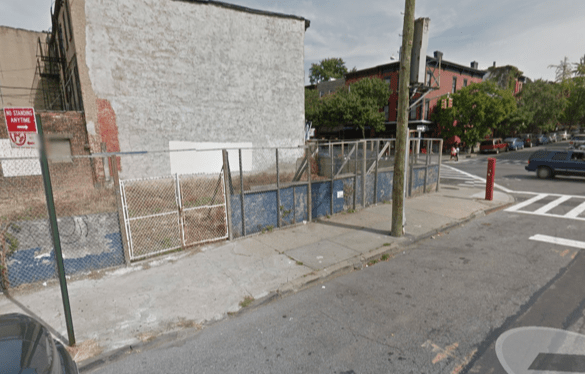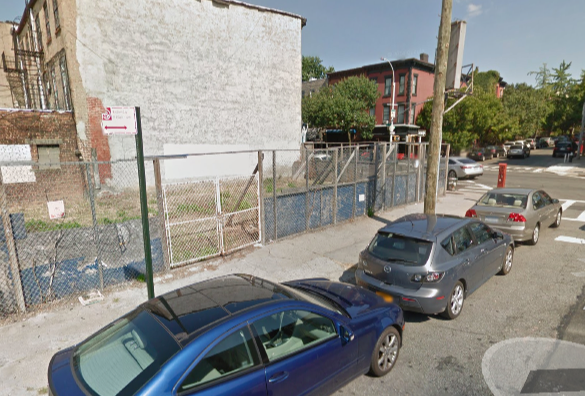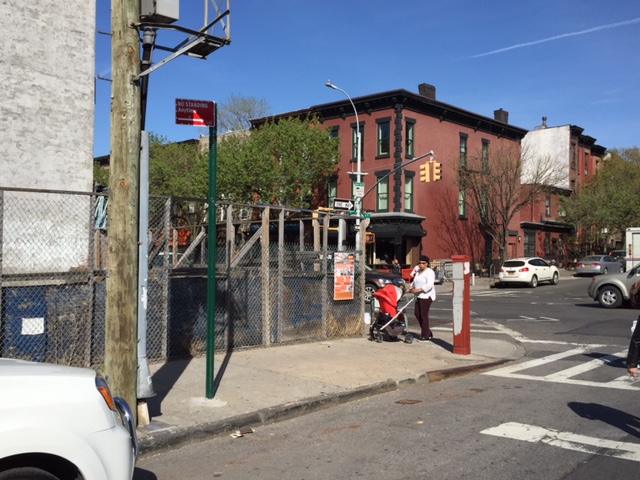Thanks @NYC_DOT for removing the loading zone on our block to gain two parking spaces. Guess what happens now? pic.twitter.com/BKVeRDKoay
— Brooklyn Spoke (@BrooklynSpoke) April 15, 2016
Whenever curb space is reallocated for bike parking in New York City, the process is intensive. Getting NYC DOT to install a bike corral usually involves lots of signature gathering, and even when a business wants one by their storefront, the local community board can shoot it down. The process can take months or even years, if it ever succeeds at all.
But if DOT decides to add curbside car parking, they often do it without a second thought -- or any public notice. Case in point: DOT has added curbside parking at two locations in Park Slope, taking away a loading zone on one street and hindering visibility on another. Neither change was brought to the local community board prior to implementation.
In October 2013, when this Google Street View photo was taken, there was roughly 15 yards of open curb on the northern corner of Baltic Street at Fifth Avenue. Approaching drivers and pedestrians could get a clear view of each other. But as of September 2014, DOT had removed a "No Standing" sign there. Now motorists may park to the edge of the west crosswalk. This makes it harder for drivers on Baltic, which is one-way eastbound, to see pedestrians as they approach Fifth. Likewise, people in the crosswalks can't see approaching vehicles as well as before.
From 2009 to 2014, two pedestrians and five cyclists were injured in crashes where Baltic meets Fifth Avenue and Park Place, according to city crash data. Three motor vehicle occupants were also hurt there during that time frame -- a sign of collisions occurring at high speeds. Another person was injured at the intersection in 2009, but city data does not indicate whether the victim was walking, riding a bike, or in a car.
New York City allows motorists to park to the edge of crosswalks, but as Streetsblog has reported, the National Association of City Transportation Officials recommends 20 to 25 feet of clearance around crosswalks to improve sight lines. Pedestrian deaths and injuries caused by turning drivers are frequent, and a bill pending in the City Council would require DOT to daylight 25 intersections per year. In other municipalities, it is simply illegal to park right up against a crosswalk.
On Second Street, DOT recently converted a daytime loading zone, located between Fourth and Fifth avenues, to a general-use parking zone. Doug Gordon, a.k.a. Brooklyn Spoke, tweeted photos of delivery drivers parked on the sidewalk since the loading zone was removed.
Previously, Gordon says, the zone allowed for delivery parking from 9 a.m. to 6 p.m. on weekdays. "With the commercial activity at the art store [near the former loading zone] and the adjacent warehouse, there are a lot of trucks and customers' cars that come and go," Gordon said in an email. "They used to use the loading zone. Now they use the sidewalk and the bike lane."
Though DOT won't install a bike corral without presenting the change to the local community board, Gordon says DOT did not seek endorsements from the Community Board 6 transportation committee, of which he is a member, before making the changes to Baltic Street or Second Street.
The double-standard makes even less sense when you consider the safety implications. Unlike parked cars, bike corrals on street corners don't obstruct lines of sight between different street users.
As it happens, Gordon and others are currently working to get a bike corral installed on Second, for employees and customers of the aforementioned art store. He writes:
I have over 200 signatures collected and am about to submit the application. But even with that level of support it would still have to go before Community Board 6 for approval. It seems absurd that one kind of street change requires community board notification but the other does not. If anything, changes that prioritize motorists over pedestrians and cyclists should be subject to community notification while things that enhance the safety and experience of pedestrians and cyclists ought to be done as a matter of course.
We asked DOT why it made these changes to the streetscape, and if in the era of Vision Zero DOT has started adding parking near crosswalks as a matter of policy. We didn't get an answer.
Update: A No Standing zone has been restored since the September 2014 Street View was captured, establishing sight lines again, but it's not as large as it used to be. Here's a current view:








